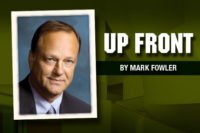Science Made to Fit
HAS THE GENERAL PUBLIC BECOME MORE CRITICAL OF SCIENCE?

Today it seems that we not only get the news we want, but the science we want as well. I think many people have become suspicious of the science used to produce studies. I once went to a major university to discuss getting a life-cycle study on a generic building assembly. They sent me a proposal starting at $250,000. Having the university’s logo on the report would be great for exposure and credibility, but why was the price so high when they use students to do most of the work? More shocking was they virtually assured me the report would be what we needed before the study was even conducted. Yet, they did teach me how to raise sponsorship and funding.
Based on experience, I had come to believe that institutions of higher learning were more independent. But over time I found out that many of these reports were skewed. The United States has time and time again trusted these reports, yet now I question almost every one of them I read. Some are obvious marketing tools that make claims that no reasonable person would believe. Most of these become irrelevant and die a deserving death. Others have inherent flaws that the authors should have caught, or maybe they assumed no one would catch the dubious information.
An Examined Eye
An example is a report that was done on testing a variety of exterior envelopes. I was allowed to review the final draft. I noticed the installers used standard interior gypsum as an exterior sheathing, and I noted that they omitted that fact in the final report. They knew of the error and said there was no real difference between these products, the data was valid. Really?
Another report I was involved with tested a variety of cladding options with various water resistant barriers (several with stucco walls). Oddly, none included two layers of Grade D paper. How could they not test the most popular stucco installation? The result essentially achieved what the sponsors set out to prove—stucco can have issues.
I recently gave a live presentation on stucco and covered why two layers of Grade D became (and remains) popular and preferred by installers. One architect replied, “I thought plastering contractors were just being cheap by using Grade D paper.” He admitted he could now see the reasons and benefits and it was not based on being cheap.
Suspicious Minds
It should not be surprising to understand why some Americans have become suspicious of science. I am not anti-vaccine or of the opinion that the Centers for Disease Control and Prevention (CDC) is a conspiratorial plot agency of the United States. However, given all the confusion, inconsistency, and political bickering, it seems that they have lessened the trust of the American people. I believe that re-gaining the trust of the American people starts with studies and reports that are more generic, sans the corporate sponsors or political agendas. Test fairly and report all the information. The U.S. was once the leader in the arena of world trust.
A study or research program should be conducted in hopes of learning something, and readers of the study should be able to have confidence that the study was not conducted by a group looking for a desired conclusion to serve a marketing plan or support an established political policy.
Maybe the testing that was done on those various claddings purposely left out the most common and successful of all stucco walls. However, I like to think (and was told) it was just an oversight. Yet, it brings up another question: Why and how did they pick a team lacking the knowledge or experience to know what is common to the specific market? Any qualified plastering expert would have caught the “oversight” or whatever we’re calling it. How often do we get stuck in the weeds and miss the big picture? Some Standards Committees are led and driven by people that have never done the work the committee focuses on. Worst of all, they do not seem to want people who do have that field experience in the room.
As a result, I now read reports with skepticism. A good report to me is one that makes sense, and is not based myths or hidden agendas. This can be hard to tell. An example would be a report I read that argued that cement plaster does not work in cold climates due to freeze-thaw issues. Sounds reasonable, except if you travel to Switzerland and see stucco on almost all buildings, it begs the question, “How can they do it?” I watched a YouTube video of someone—not in Europe—trying to explain the “special” processes used to make it work. I had to laugh. I’ve worked in construction. I know how they do it. It’s nothing special! (Ironically, this person was also selling his services to building owners and designers.)
I believe in science. But I also believe in common sense. I think it’s okay to trust in science. There just needs to be a level of wariness regarding what the agenda could be of the people behind the science, and why.
Looking for a reprint of this article?
From high-res PDFs to custom plaques, order your copy today!





